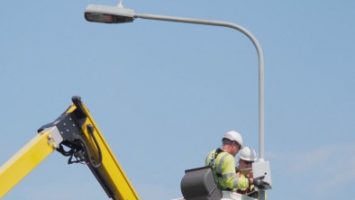
By Michael Tschirret, Marketing Communications Manager for Smart Cities, Sensus
These days, every city wants to be “smart.” But what is smart? Monitoring refuse levels of trash cans? Digital signage directing you to an open parking spot? Autonomous vehicles? Yes, yes, and yes. The point is, there’s no end to ways a city can become smarter. But for many municipalities, “smart” means outdoor lighting control.
“But wait,” you think — “My city already has new LED (Light Emitting Diode) lighting — isn’t that smart?” It is, but only the beginning of a smart lighting strategy. To be truly smart, outdoor lighting controls need to be deployed. Consisting of a module typically mounted on top of the light fixture and software that monitors and regulates various functions such as dimming, emergency alerts, flashing, alarm management and event scheduling, a lighting control system enables new levels of efficiency.
Without a doubt, outdoor lighting has come a long way since the advent of the humble photocell. Gone are the days of a light fixture’s intelligence being limited to sensing the presence of light, and thereby turning on or off. The vast majority of photocells last no more than ten years at best — and when they do expire at night, they can lead to a phenomenon known as “dayburners”– a permanent “on” state in the middle of the day, all day, every day. On their own, dayburners can account for up to 15 percent of a city’s utility budget. Compare that scenario to modern lighting control using an atomic clock and GPS and suddenly, you’ve got instant return on investment.
And while lighting control brings a host of new technology and functionality to bear, it does so at a very low barrier to entry. Modules themselves are relatively inexpensive, and require no technical expertise to install — simply insert into a standard NEMA (National Electrical Manufacturers Association) socket, and twist. The light fixture then relays information about the module to the software, and in some instances can even provide instant asset management by populating the type of fixture and bulbs in use. This represents only a fraction of the data that can be extracted from the system at any given time. Do you know how many lights your city has?
Smart lighting is truly the best of all worlds. It’s inexpensive technology that is easy to deploy, and provides numerous economic, safety, and energy conservation benefits that are well within your reach. It’s a smart strategy that provides valuable benefits for your constituents and will illuminate your city in more ways than one.
For more information, check out the Sensus video, “The Role of Smart Lighting.” And if you’d like a deeper dive, we also offer a companion Viewpoint on the subject.
Michael Tschirret is a Marketing Communications Manager at Sensus. He is responsible for all outbound marketing, campaigns and events involving Smart Cities, Smart Lighting and the Internet of Things (IoT). Entering his fourth year at Sensus, Michael previously supported marketing efforts for the FlexNet Communications network.
Prior to Sensus, Michael was the Marketing Communications Manager for Wireless and Fiber Optic test and measurement solutions at Viavi. He has over 20 years of wireless and communication network expertise, to include product marketing and business development positions at Nortel and Agilent Technologies.
Michael holds a B.S. degree from the Florida State University, and an M.S. in Urban Planning from Virginia Tech.


